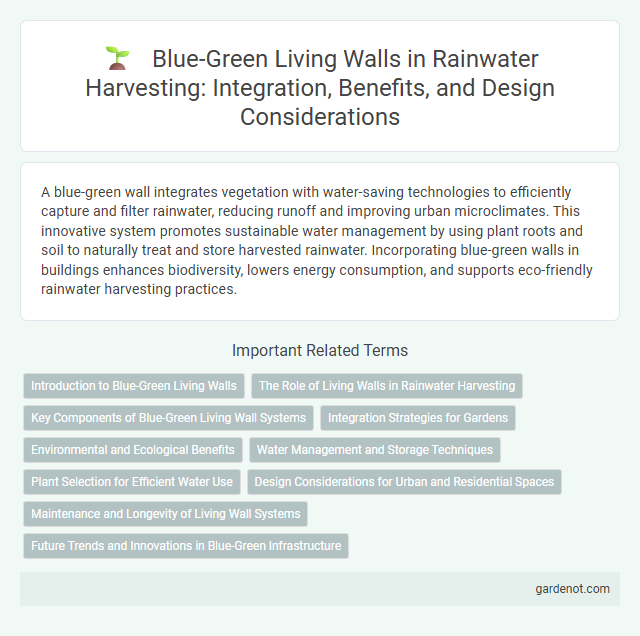A blue-green wall integrates vegetation with water-saving technologies to efficiently capture and filter rainwater, reducing runoff and improving urban microclimates. This innovative system promotes sustainable water management by using plant roots and soil to naturally treat and store harvested rainwater. Incorporating blue-green walls in buildings enhances biodiversity, lowers energy consumption, and supports eco-friendly rainwater harvesting practices.
Introduction to Blue-Green Living Walls
Blue-green living walls integrate rainwater harvesting with vertical vegetation systems, promoting sustainable urban water management and enhancing building insulation. These walls consist of plants, soil substrates, and advanced irrigation technologies that capture and reuse rainwater, reducing runoff and improving air quality. By combining ecological design with water conservation, blue-green walls contribute to stormwater mitigation and urban biodiversity.
The Role of Living Walls in Rainwater Harvesting
Living walls, also known as blue-green walls, play a crucial role in rainwater harvesting by capturing and filtering rainfall through their vegetation and substrate layers. These structures enhance urban water management by reducing runoff, improving water infiltration, and promoting evapotranspiration, which collectively decreases the burden on stormwater systems. Incorporating living walls into urban design supports sustainable water cycles and mitigates flooding risks in densely populated areas.
Key Components of Blue-Green Living Wall Systems
The key components of blue-green living wall systems include a structural support framework, a waterproof membrane, and an integrated irrigation network designed for efficient rainwater harvesting and distribution. These walls feature specialized growth media that retain moisture and promote plant health while facilitating natural water filtration. Incorporating sensor technology optimizes water usage, enhancing sustainability and reducing runoff in urban environments.
Integration Strategies for Gardens
Blue-green walls integrate rainwater harvesting in garden designs by combining vertical vegetation with water management systems that capture and utilize rainwater efficiently. These walls employ permeable substrates and irrigation channels to store and distribute harvested rainwater, reducing runoff and supporting plant growth. Utilizing native and drought-tolerant species enhances water retention and promotes sustainable garden ecosystems.
Environmental and Ecological Benefits
Blue-green walls enhance rainwater harvesting by efficiently capturing and filtering stormwater, reducing runoff and mitigating urban flooding risks. These living walls improve air quality, promote biodiversity by providing habitat for various species, and contribute to cooling urban heat islands through evapotranspiration. Integrating blue-green walls into urban infrastructure supports sustainable water management and fosters resilient ecosystems in densely populated areas.
Water Management and Storage Techniques
Blue-green walls integrate vegetation and water storage systems to enhance rainwater harvesting efficiency, reducing runoff and promoting natural filtration. These walls use porous substrates and built-in reservoirs to capture and retain rainwater, enabling gradual absorption and reuse for irrigation. Advanced water management techniques in blue-green walls optimize storage capacity and support sustainable urban water cycles by reducing demand on municipal supplies.
Plant Selection for Efficient Water Use
Selecting drought-tolerant and native plant species is crucial for blue-green walls to maximize rainwater harvesting efficiency and reduce irrigation needs. Succulents like Sedum and drought-resistant grasses absorb and retain rainwater effectively, promoting sustainable water cycles. Incorporating deep-rooted plants enhances water retention and prevents runoff, optimizing the overall performance of the rainwater harvesting system.
Design Considerations for Urban and Residential Spaces
Blue-green walls in urban and residential rainwater harvesting systems require strategic design considerations, including selecting native plant species that enhance water absorption and filtration efficiency. Integrating permeable substrates and modular irrigation systems optimizes rainwater retention while minimizing runoff. The design must also account for local climatic conditions and structural support to ensure durability and environmental benefits.
Maintenance and Longevity of Living Wall Systems
Regular maintenance of blue-green walls ensures optimal rainwater harvesting by preventing clogging and maintaining plant health, which enhances water retention capacity. Monitoring irrigation systems and replacing any damaged components prolongs the lifespan of living wall structures. Selecting hardy plant species and incorporating efficient drainage solutions further supports the longevity and sustainability of rainwater harvesting systems integrated into green walls.
Future Trends and Innovations in Blue-Green Infrastructure
Blue-green walls are evolving with innovations like integrated rainwater harvesting systems that enhance urban water management and reduce runoff. Future trends emphasize smart sensors and IoT technology to optimize irrigation based on real-time moisture data, increasing water efficiency. Advances in sustainable materials and bioengineered plants further improve the durability and ecological benefits of blue-green infrastructure.
Blue-green wall Infographic

 gardenot.com
gardenot.com